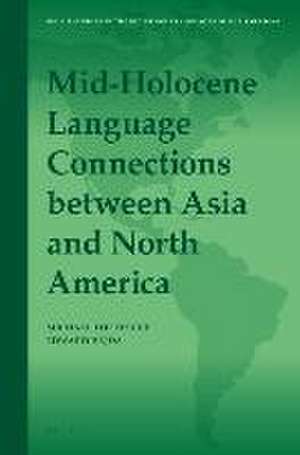Mid-Holocene Language Connections between Asia and North America: Brill's Studies in the Indigenous Languages of the Americas, cartea 17
Autor Edward Vajda, Michael Fortescueen Limba Engleză Hardback – 26 ian 2022
Preț: 753.78 lei
Preț vechi: 919.25 lei
-18% Nou
Puncte Express: 1131
Preț estimativ în valută:
144.23€ • 150.59$ • 119.37£
144.23€ • 150.59$ • 119.37£
Carte indisponibilă temporar
Doresc să fiu notificat când acest titlu va fi disponibil:
Se trimite...
Preluare comenzi: 021 569.72.76
Specificații
ISBN-13: 9789004436817
ISBN-10: 9004436812
Dimensiuni: 155 x 235 mm
Greutate: 0 kg
Editura: Brill
Colecția Brill
Seria Brill's Studies in the Indigenous Languages of the Americas
ISBN-10: 9004436812
Dimensiuni: 155 x 235 mm
Greutate: 0 kg
Editura: Brill
Colecția Brill
Seria Brill's Studies in the Indigenous Languages of the Americas
Cuprins
List of Tables and Illustrations
Abbreviations
Introduction
Michael Fortescue and Edward Vajda
1 Overview
2 The Eskaleut, Uralic and Yukaghir Languages
2.1Eskaleut
2.2Uralic
2.3Yukaghir
3 The History of the Hypothesis
4 Uralo-Siberian Cognates
4.1The Basis of the Reconstructions: Sound Correspondences
4.2Proto-Uralo-Siberian Stems
4.3Proto-Uralo-Siberian Morphology
4.4Summary
5 The Relationship to Chukotko-Kamchatkan
6 The Emergence of Ergativity in Eskaleut and Siberian Languages
7 Aleut Lexical Items Not Attested in Eskimoan: Evidence of a Substratum?
8 Sirenikski: Remnant Asian Eskimoan
8.1The Position of Sirenikski within Eskimoan
8.2Sirenikski Phonology and Lexicon
8.3Sirenikski Morphology
8.4The Idiosyncrasy of Sirenikski
9 Support from Archaeology and Population Genetics
9.1The Dispersal of Uralo-Siberian: A Model
9.2Archaeological Support for the Model
9.3Genetic Support for the Model
1 Overview
2 Yeniseian Languages
3 Na-Dene: Tlingit, Eyak, and Dene (Athabaskan) Languages
4 Dene-Yeniseian Phonology
5 Dene-Yeniseian Cognates
6 Form Classes and Noun Morphology
7 Possessive Constructions
7.1Yeniseian Possessive Morphology
7.2Dene-Eyak Noun Class Markers and Qualifiers
7.3Postpositional Constructions
7.4Directionals
7.5Demonstratives and Interrogatives
7.6Summary
8 Finite Verb Morphology
8.1The Origin of Dene-Yeniseian Templatic Polysynthesis
8.2Na-Dene Classifier Prefixes
8.3The Proto-Yeniseian Template
8.4Tense-Aspect-Mood Affixes
8.5Agreement Morphology
8.6Contact-Induced Changes in the Yeniseian Daughter Templates
8.7Areal Influence on Na-Dene Verb Morphology
8.8Action Nominals
8.9Concluding Remarks on Dene-Yeniseian Verb Morphology
9 Summary of the Linguistic Evidence for Dene-Yeniseian
10 Perspectives on Dene-Yeniseian from Genetics and Archaeology
11 Summary and Future Perspectives
Concluding Discussion
Michael Fortescue and Edward Vajda
Appendix 1: P-US to English; English to P-US
Appendix 2: P-DY to English; English to P-DY
References
Index
Abbreviations
Introduction
Michael Fortescue and Edward Vajda
Part 1 The Uralo-Siberian Hypothesis
1 Overview
2 The Eskaleut, Uralic and Yukaghir Languages
2.1Eskaleut
2.2Uralic
2.3Yukaghir
3 The History of the Hypothesis
4 Uralo-Siberian Cognates
4.1The Basis of the Reconstructions: Sound Correspondences
4.2Proto-Uralo-Siberian Stems
4.3Proto-Uralo-Siberian Morphology
4.4Summary
5 The Relationship to Chukotko-Kamchatkan
6 The Emergence of Ergativity in Eskaleut and Siberian Languages
7 Aleut Lexical Items Not Attested in Eskimoan: Evidence of a Substratum?
8 Sirenikski: Remnant Asian Eskimoan
8.1The Position of Sirenikski within Eskimoan
8.2Sirenikski Phonology and Lexicon
8.3Sirenikski Morphology
8.4The Idiosyncrasy of Sirenikski
9 Support from Archaeology and Population Genetics
9.1The Dispersal of Uralo-Siberian: A Model
9.2Archaeological Support for the Model
9.3Genetic Support for the Model
Part 2 The Dene-Yeniseian Hypothesis
1 Overview
2 Yeniseian Languages
3 Na-Dene: Tlingit, Eyak, and Dene (Athabaskan) Languages
4 Dene-Yeniseian Phonology
5 Dene-Yeniseian Cognates
6 Form Classes and Noun Morphology
7 Possessive Constructions
7.1Yeniseian Possessive Morphology
7.2Dene-Eyak Noun Class Markers and Qualifiers
7.3Postpositional Constructions
7.4Directionals
7.5Demonstratives and Interrogatives
7.6Summary
8 Finite Verb Morphology
8.1The Origin of Dene-Yeniseian Templatic Polysynthesis
8.2Na-Dene Classifier Prefixes
8.3The Proto-Yeniseian Template
8.4Tense-Aspect-Mood Affixes
8.5Agreement Morphology
8.6Contact-Induced Changes in the Yeniseian Daughter Templates
8.7Areal Influence on Na-Dene Verb Morphology
8.8Action Nominals
8.9Concluding Remarks on Dene-Yeniseian Verb Morphology
9 Summary of the Linguistic Evidence for Dene-Yeniseian
10 Perspectives on Dene-Yeniseian from Genetics and Archaeology
11 Summary and Future Perspectives
Concluding Discussion
Michael Fortescue and Edward Vajda
Appendix 1: P-US to English; English to P-US
Appendix 2: P-DY to English; English to P-DY
References
Index
Notă biografică
Michael Fortescue, Ph.D. (1978), Edinburgh University, is professor emeritus in Linguistics at the University of Copenhagen. He has published widely in the field of Arctic languages, including West Greenlandic (Croom Helm, 1984). He co-authored The Comparative Eskimo Dictionary (Alaska Native Language Center, 1994, 2010).
Edward Vajda, Ph.D. (1987), University of Washington, is professor of Russian, Eurasian Studies, and Linguistics at Western Washington University. His research focus is the indigenous languages of northern Asia, particularly Ket and other Yeniseian languages. His books include Yeniseian Peoples and Languages (Curzon Press, 2001) and Ket (Lincom, 2004).
Edward Vajda, Ph.D. (1987), University of Washington, is professor of Russian, Eurasian Studies, and Linguistics at Western Washington University. His research focus is the indigenous languages of northern Asia, particularly Ket and other Yeniseian languages. His books include Yeniseian Peoples and Languages (Curzon Press, 2001) and Ket (Lincom, 2004).













